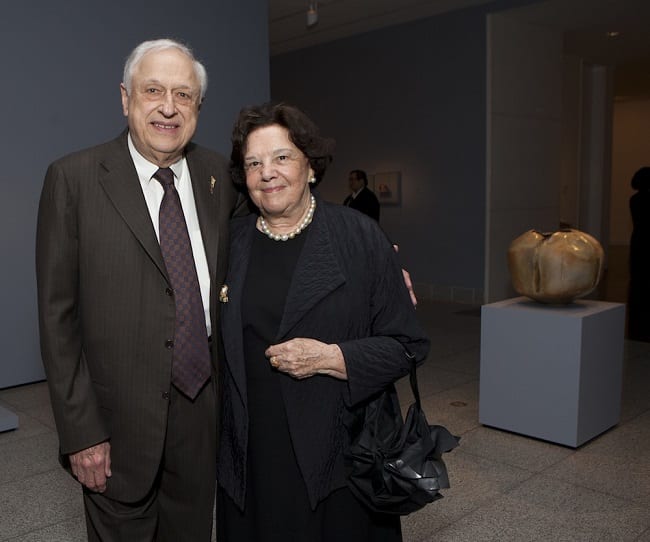It would be impossible to be in ceramics in America from 1970 onwards and not to know, or at least know about, the Washington D.C. couple, Lee and Melvin Eagle. And one might know them for their collection but more likely it would be because of their service. Jointly and separately they served on the advisory board of the James Renwick Alliance (Mel served at president), the Mint Museum, the American Craft Council (Lee served as president) and numerous other institutions both within the crafts and beyond.
My own experience of their clout in the world of culture was when I was determined to find a ticket to a sold-out Sondheim Series at the Kennedy Center a few years ago. I tried everything and everyone, including scalpers, to find a pair of tickets for my partner and I, but with no luck. A call to the Eagles netted us box seats alongside the presidents box which was, unsurprisingly, empty.
The Museum of Fine Arts, Houston, is currently presenting Beyond Craft: Decorative Arts from the Leatrice S. and Melvin B. Eagle Collection (February 23 to May 26, 2014). The full collection comprises 170 extraordinary artworks —ceramics, fiber work, furniture, glass, jewelry and works on paper— acquired by the Museum in 2010. This exhibition is explored in another post in this issue.
What caused you to go into the ceramic supply business? Was Eagle Ceramics a purely business opportunity or had you already fallen under the spell of the kiln?
Lee: “I studied ceramics at local colleges in the late 1960s and early 1970s. There came a time in about 1972 when I needed a studio to work in at home which meant buying equipment and materials. There was no convenient supply company to do that in the D.C. area.”
Mel: “I had a business at the time, so I contacted suppliers around the country and became a distributor for everything Lee needed. First her friends and then the University of Maryland ceramics department found out and wanted her to get their equipment and materials too. By 1973, there was enough demand that we rented a warehouse, and, not long after, began publishing a catalog.”
Lee: “By 1974, the business had grown so much that I had to give up being a maker and run it. I built it for 10 years – it became the second largest in the country – and (I) sold (it) in early 1984 in order to go to law school.”
There was a point at which you must have noticed a change in the field, a heightened ambition. Do you think that the opening of American Hand gallery marked that point? Or did it begin earlier?
“By the time we encountered the American Hand, it had been open for some time. It certainly had an impact on us. It’s hard to point to a specific “aha” moment. There was more of a continuing process of learning and changing: it started because we were energized by the groups of artists that orbited around the WWII veterans that came back, studied art/ceramics/sculpture under the GI Bill, and others that were offshoots: Voulkos was certainly key in California, leading to developments of hotbeds in LA, UC Davis and the Bay Area. Like many, we were swept up by the force of their creative energy.”
What interests me is that the core of that movement was the Chouinard Group; Elsa Rady, Adrian Saxe, and of course the maestro, Ralph Bacerra. This is also the epicenter of your collection. What about these artists connected so strongly in Washington D.C., perhaps even more popular there than in their hometown of Los Angeles?
“All credit to the American Hand. They brought those artists to D.C. and promoted their work – we just were taken with the virtuosity they displayed. As you well know, their work is among the best designed and crafted of the era. The aesthetics appealed to us then and now.”
Having watched your collection grow I notice that in the beginning it was at least part circumstantial; artists you worked with from Eagle Ceramics, works from workshops you sponsored and then suddenly it changed, broadened, grew in stature and ambition. Was there a moment when you recognized that shift? Was there a specific acquisition that was the turning point?
“All evolutionary but there was never a moment when we said, ‘We’re building a collection that we want to go to a museum.’ It’s true that the connections that we made during the Eagle Ceramics and workshop years played a role. It’s also true that getting involved with museums broadened our thinking. Meeting and talking with dealers – you and Mark, Nancy Hoffman, Franklin, and others – have educated us in the artistic values and in the entire art universe.”
“Ex”-dealer now. What is your opinion of ceramic art today by the under 40’s? Does it excite you, how has it changed from where you began and will this be the source for a new collection?
“We see too much work that bears a resemblance to the earlier ‘gods of clay.’ Too many makers that want to be treated like accomplished artists without putting in the time and effort to allow their talent to flourish on a firm foundation. We do own work of two younger artists that we think are doing well: Steven Lee, also director at Archie Bray, and Jesse Small, (of the) KC Art Institute and studied in China.”
Garth Clark is the Chief Editor of CFile.
Above image: Melvin and Leatrice Eagle in front of their Ruth Duckworth (1919-2009) “Mama Pot” c. 1986. Photograph by Jenny Antill.
Any thoughts about this post? Share yours in the comment box below.
Visit the Eagle Collection at the MFA-H

interesting interview – thank you! ordering the catalog!
Great blog you have got here.. It’s difficult to
find good quality writing like yours nowadays. I seriously appreciate people like you!
Take care!!